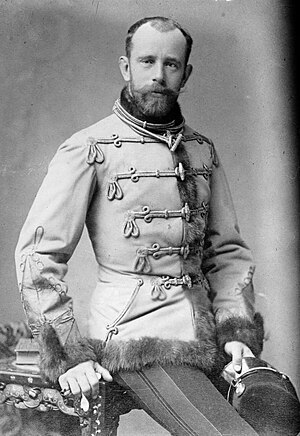Rudolf I of Greater Austria
| Rudolf I | |
|---|---|
| King of Bohemia, Croatia, Slavonia and Dalmatia, Galicia and Lodomeria | |
 | |
| Emperor of Greater Austria | |
| Reign | 11 January 1902 - 25 August 1934 |
| Inauguration | 21 August 1902 |
| Predecessor | Monarchy established |
| Successor | Rudolf II |
| Emperor of Austria King of Hungary | |
| Reign | 20 February 1891 - 11 January 1902 |
| Predecessor | Franz Joseph I |
| Successor | Himself as Emperor of Greater Austria |
| Born | Rudolph Francis Charles Joseph 21 August 1858 Schloss Laxenburg, Laxenburg, Lower Austria, Austrian Empire |
| Died | 25 August 1934 (aged 76) Schönbrunn Palace, Vienna, Greater Austria |
| Burial | |
| Spouse | |
| Issue | |
| House | Habsburg-Lorraine |
| Father | Franz Joseph I |
| Mother | Elisabeth in Bavaria |
| Religion | Roman Catholicism |
Rudolf I (Rudolph Francis Charles Joseph; 21 August 1858 - 25 August 1934), better known as Rudolf the Unifier was the first Emperor of Greater Austria from 11 January 1902 to 25 August 1934 of the United States of Greater Austria. He was previously Emperor of Austria, King of Hungary (as Rudolf II), and the other states of the Austro-Hungarian Empire from 20 February 1891 to 11 January 1902.
A liberal-minded and reformist monarch, he ascended to the throne on 20 February 1891, having successfully convinced his father, Emperor Franz Joseph I to abdicate the throne. Soon afterwards, he personally led efforts to effectively reform the rather fragile state of the Austro-Hungarian Empire, which had been plagued by issues of nationalism coming from its various ethnic minorities. Under the influence of the Romanian-born lawyer and politician, Aurel Popovici, the delicate process of federalising the Empire ultimately concluded with success, thereby establishing the United States of Greater Austria. However, major Hungarian opposition to such a concept led to the beginning of the Third Balkan War, which Austria and its ally, Greece decisively won against Hungary and her allies, Serbia and Romania. Then, with support from moderate left-wing politicians in the Empire, more steps were taken to further solidify the new and refined imperial entity introduced by Rudolf himself. Around a decade later, he successfully kept Greater Austria out of the First World War, which involved its ally, Germany against the Triple Entente. With the subsequent defeat and dismemberment of the German Empire in 1919 and the collapse of the Tsarist regime in Russia, Greater Austria emerged largely unscathed from the war as the pre-eminent power in Central Europe.
Amidst the tense political atmosphere that followed the end of the First World War, Rudolf personally sought to suppress radical movements from both the left and right, which aroused some controversy. Nonetheless, the Empire remained relatively stable throughout the rest of his reign, with the economy experiencing modest growth prior to the onset of the Great Depression on August 1929. On August 1934, he passed away at the age of seventy six, and was succeeded by his son, Rudolf II.
Early Life
Crown Prince
Reign
Emperor of Austria, King of Hungary
Emperor of Greater Austria
First World War
Post-War
Death
Personal Life
Titles & Honours
- 21 August 1858 - 20 February 1891 His Imperial and Royal Highness The Crown Prince of Austria, Hungary, Bohemia and Croatia
- 20 February 1891 - 11 January 1902 His Imperial and Royal Apostolic Majesty The Emperor of Austria, Apostolic King of Hungary
- 11 January 1902 - 25 August 1934 His Imperial Majesty The Emperor of Greater Austria
Ancestors
| Ancestors of Rudolf I of Greater Austria |
|---|